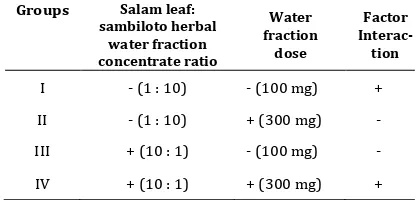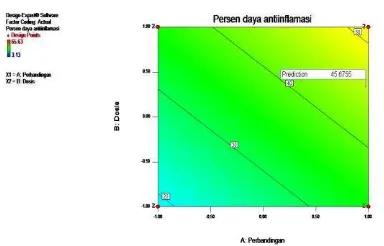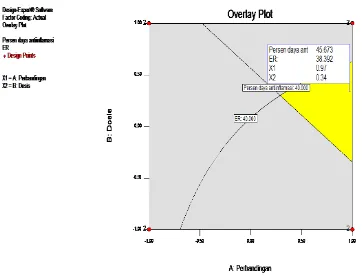Proceeding - ICB Pharma II
Current Breakthrough in Pharmacy Materials and Analyses ISSN : 9-772476-969006
23 | P a g e
OP
A008
PHARMACEUTICAL TECHNOLOGY
Optimizing Combination of
Sambiloto
Herbal Water Fraction and
Salam
Leaf
Water Fraction As Anti-Inflammation
Raymond Harris Mustafa
1, Lannie Hadisoewignyo
1*, Martha Ervina
1, Lisa Soegianto
1,
Wahyu Dewi Tamayanti
11Faculty of Pharmacy, Widya Mandala Surabaya Catholic University
Surabaya, Indonesia
*E-mail: [email protected]
Abstract—Sambiloto herbs (Andrographis paniculata Nees) and salam leaves (Syzygium polyanthum), which are effective to reduce blood sugar level with different mechanism, have been suggested to produce a synergy as antioxidant and anti-inflammatory agent, hence the optimum combination formula is remained to be elaborated. By reducing blood sugar level and showing antioxidant, and anti-inflammatory activity, both plants were hypothesized of its ability ameliorating diabetes mellitus complexicity. This study aimed to discover the optimal combination formula sambiloto herbs (Andrographis paniculata Nees) and salam leaves (Syzygium polyanthum) water fraction to produce anti-inflammation effect. Carrageenan was used to induced the inflammatory condition. Optimization was conducted by factorial design utilising 2 factors and 2 levels. Both factors, sambiloto herbs (Andrographis paniculata Nees) and salam leaves (Syzygium polyanthum) in the range of low level 1:10 and high level 10:1 with the used doses were 100 mg/kg BW at low level and 300 mg/kg BW for high level. The observed parameters were anti inflammation potential percent and edema rate. Conclusively, this study proposed that optimum combination formula of sambiloto herbal : salam leaves water fraction = 1.14 : 9.87 with 234 mg dose. The combination formula was theoretically resulted the optimum anti inflammation potential percent of 45.68%, and ER of 38.39% compared with other combination formulas.
Keywords—salam leaf; sambiloto herbal; water fraction; anti inflammation; factorial design
I. INTRODUCTION
There are many plants to treat diabetes including sambiloto herbal (Andrographis paniculata Nees) and salam leaf (Syzygium
polyanthum). Both plants work to decrease or reduce blood sugar by different ways, hence it is expected that both have a synergic effect as
evidenced by Widjajakusuma s [ ], tight
blood sugar decrease effect is higher than the combination of two extracts than single extract. This combination is expected not only able to better decrease sugar level but it can prevent further complication from Diabetes mellitus through its ability in blocking free radical which is related to its antioxidant and anti inflammatory effect.
Based on Hadisoewignyo et al (2012) [2] research, it is found that in single use, sambiloto herbal water fraction has greater anti inflammation capability than salam leaf water fraction, but in their combination use with salam leaf water fraction to sambiloto herbal water fraction of 2 :1 provides greatest anti inflammation capability.
This research aimed to identify comparison between sambiloto herbal water extract fraction and salam leaf water fraction which possess optimum anti inflammatory effect. Optimize design used was factorial design with two factors and two levels using assisted by the design expert program.
II. MATERIALS AND METHODS
A. Instruments
Instruments used in this research were percolator, Rotavap, spectrophotometer UV-VIS, High Performance Chromatography (HPLC), UV lamp, and KLT plate.
B. Plant materials
24 | P a g e Proceeding - ICB Pharma II Current Breakthrough in Pharmacy Materials and Analyses
ISSN : 9-772476-969006 determined from Materia Medika Indonesia
(MMI), Batu, Indonesia.
C. Chemical materials
Methanol, n-hexane, ethyl acetate, ethanol 96%, chloroform, quersetin, water for injection, NaCL 0,9%, ether, carrageenan, and tylose.
D. Animals
Animal used to evaluate anti inflammation and ulcerogenic tests were Wistar male white rats (Rattus norvegicus) mean age of 2 to 3 months, 150-200 g body weight. The project was previously approved by the Animal's Ethics Committee of the Laboratory Research and Testing of Integrated of Gadjah Mada University, Indonesia.
E. Standardization of Simplicia
In simplicia standardization of herbal sambiloto and salam leaf, ash level determination, ethanol solution extract content determination and water soluble extract content determination tests were performed according to Materia Medika requirements [3].
F. Sambiloto Herbal Etanol Extract Water Fraction and Salam Leaf Ethanol Extract Water Fraction Production
Sambiloto extract and Salam leaf extract production were performed in percolation manner. Stages to be performed were following: simplicia powder of sambiloto/salam leaf is weighted and entered to percolator; the powder is macerated with ethanol 96% for 24 hours and sometimes is stirred. After 24 hours, ethanol extract is filtered with sieve paper (macerate I) and the residue is re-macerated with ethanol 96%; after 24 hours, ethanol extract is filtered (macerate II). Then Macerate I and II are combined and thickened using evaporator following with heating in a porcelain dish on stem bath until thick extract is obtained. A thick extract obtained is weighted and dissolved with 90% methanol-water. Staged fractionation is performed in separate funnel with n-hexane by shaking for 5 minutes and n-hexane fraction is separated. Fractionation is performed several times until hexane fraction is colorless. All n-hexane fractionation obtained is combined and thickened in the evaporator. Methanol-water fraction is vaporized in a porcelain dish above steam bath until the methanol vaporizes and water fraction is obtained. Water fraction is fractioned with ethyl acetate in separate funnel like in n-hexane fraction. All ethyl acetate fractions obtained are combined and thickened in the evaporator. Water fraction obtained from fractionation residue wit ethyl acetate is thickened
in a porcelain dish on the steam bath. At the end of extraction total extract, hexane fraction, ethyl acetate fraction and water fraction from sambiloto and salam leaf are obtained.
G. Standardization of Extract
Tests performed on extract standardization are organoleptic tested, pH determination, water level test, water diluted essence level test, ethanol diluted essence level test, and chromatogram profile from the merit material.
H. Optimization Design
Factorial design in this research used 2 factors and 2 levels for respective factors. Factors used are salam leaf water fraction concentration: sambiloto herbal water fraction comparison and the water fraction dose used. For salam leaf water fraction: sambiloto herbal water fraction concentration comparison, low level used was 1 : 10 and high level 10 : 1, while for water fraction dose factor used, low level 100 mg/kg BW and high level of 300 mg/kgBW. Design framework can be seen in table I.
Tabel 1. Optimization with factorial design
Groups Salam leaf: sambiloto herbal
I. Anti inflammation test procedure (Anonym, 1993)
Proceeding - ICB Pharma II
Current Breakthrough in Pharmacy Materials and Analyses ISSN : 9-772476-969006 (Ghamdi, 2001). The Antiiflammation capability percent is determined as in equation (2).
.(2) AUCp is treatment group AUC and AUCk is control group AUC.
III. RESULT AND DISCUSSION
A. Standardization of Simplicia
Simplicia quality test performed include: dried shrinking, total ash content, level of water soluble, and level of ethanol soluble. Observation result can be seen in table 2.
Table 2. Result Of Salam Leaf And Sambiloto Herbal Simplicity Standardization
No Test Parameter
Salam Leaf Sambiloto Herbal
Require-provide internal and external mineral content figure derived from initial process to the forming of dried simplicity. Total ash content determination result of sambiloto herbal simplicity has fulfilled the standard requirement that is not more than 12% [4] and salam leaf has not fulfilled the standard requirement that is not more than 5% [5]. Level of water soluble and level of ethanol soluble determination test showed that sambiloto
herbal has fulfilled the requirement of not less than 18% and 9,7 % [4] while level of water soluble of salam leaf has not fulfilled standard
requirements and level of ethanol soluble has fulfilled the requirement of not less than 8%.
B. Preparation of Sambiloto Herbal and Salam Leaf Extracts
Preparation of sambiloto extract and salam leaf extract are both using percolation method. The final result of extract preparation produced
sambiloto extract with rendement in 19.7%; while for salam leaf extract with 20.3% rendement.
C. Standardization of Extract
In extract standardization, tests performed were organoleptic (color, taste, and smell), pH, and ash content and the result is listed in Table III.
Table 3. Standardization of Extract
Extract Organoleptic pH Ash Content
Sambiloto
Preparation of fractioned extracts from sambiloto and salam leaf is performed by
fluid-Sambiloto Salam Leaf
Weight
E. Standardization of Fraction
In water fraction standardization tests performed were following organoleptic (color, taste, and smell), pH, and ash content, the result is listed in table 5.
Table 5. Standardization Of Water Fraction
Water Fraction Organoleptic pH Ash Content
Sambiloto Herbal
Salam Leaf Etanol Extract Water Fraction
Color: Dark brown Taste : tasteless Smell : characteristic
26 | P a g e Proceeding - ICB Pharma II Current Breakthrough in Pharmacy Materials and Analyses
ISSN : 9-772476-969006
F. Anti inflammation test
In this research, rat paw volume is observed using plethysmometer and edema volume is measured which occurred about 0 hours to 4th hour. Then a graph depicting relationship between mean edema volume and time (figure 1) is made. Edema peak is obtained due to carrageenan induction in inflammation control group, occurring in 2.5 to 3 hours. Smallest edema volume occurred with use of Salam leaf water fraction: sambiloto herbal water fraction combination in 10:1 ratio, both at 10 mg/kgBW dose and 300 mg/kgBW dose. While the combination with greatest edema volume is a
salam leaf water fraction: sambiloto herbal water fraction at 1 : 10 ratio at 100mg/kgBW dose.
Figure 1. Relationship Between Cumulative Mean Edema Volume (Cm3) And Time (Hour)
G. Optimization with Factorial Design
Optimization of salam leaf water fraction and sambiloto herbal water fraction comparison and optimum dose searching is performed by using a factorial design method associated with the design expert program. Based on anti inflammation capability percent data mathematical equation as the following is obtained:
Y = 35,16 + 7,81 XA + 8,59 XB + 1,25x10 -3XAXB...(3)
Y is anti inflammation capability percent (%) response. XA is the value of the salam leaf water fraction and sambiloto herbal water fraction comparison. XB is dose value and XA XB is value of interaction of salam leaf-sambiloto herbal water fraction and dose. Of the equation (3) contour plot as in figure 2 is obtained.
Based on equation (3) and contour plot in Figure 2, it is seen that dose factor has greater effect on anti inflammation capability resulted compared with the salam leaf water fraction and sambiloto herbal water fraction comparison factor. The interaction of both factors has a small effect on response resulted.
Figure 2. Contour plot of anti inflammation capability percent.
Based on the edema rate (ER) date, a mathematical equation is obtained as follows:
Y = 39,70 - 3,3 XA + 3,52 XB +
2,18XAXB...(4)
Y is ER response (%). XA is the value from salam leaf water fraction and sambiloto herbal water fraction comparison, Xb is dose value, and XaXb is value of interaction of sambiloto herbal-salam water fractions and dose comparison. Of the equation (12) contour plot as in figure 3 is obtained.
Based on equation (4) and contour plot in Figure 3, it is seen that salam leaf water fraction and sambiloto herbal water fraction comparison factor can reduce ER value, hence in the formulation of the two materials combined the comparison to be used should be considered, since it will influence their ability in blocking edema.
Figure 3. Contour plot of edema rate.
Proceeding - ICB Pharma II
Current Breakthrough in Pharmacy Materials and Analyses ISSN : 9-772476-969006
27 | P a g e
Figure 4. Superimposed Contour Plot Of Salam Leaf Water Fraction And Sambiloto Herbal Water Fraction Combination
Based on the yellow area in the superimposed contour plot optimum formula can be selected that is: formula that use salam leaf water fraction: sambiloto herbal water fraction comparison of 9,865 : 1,135 to 234 mg doses, providing theoretical results for anti inflammation capability percent of 45,68% and ER of 38,39%.
IV. CONCLUSION
Smallest edema volume occurred on use combination of salam leaf water fraction:
sambiloto herbal water fraction by 10:1 ratio at 100 mg/kgBW or 300 mg/kgBW doses. Optimum formula can be made by using salam
leaf water fraction to sambiloto herbal water fraction ratio of 9,865:1,135 at 234 mg dose which give theoretical results in an inflammation capability percent of 45,68% and ER of 38.39%.
Acknowledgment
Authors thank to Directorate General of Higher Education who had funded this research through the scheme Penelitian Unggulan Perguruan Tinggi.
References
[1]. Widjajakusuma, EC, Hendriati, L, Ferawati, dan Surjadhana, A: Toxicity Test and Pharmacology of Andrographis paniculata and anticancer of Centella asiatica, Research Report of Traditional Medicine Research Centre, Widya Mandala Surabaya Catholic University, 2009.
[2]. M. Young, The Technical Writer s (andbook. Mill Valley, CA: University Science, 1989.
[3]. Hadisoewignyo, L, Ervina M , dan Soegianto, L: Antioxidants Activity, Anti-inflammatory, and Ulcerogenic Test of Combination of Sambiloto Extract and Salam Leaf Extract as regards the Antidiabetic, Research Report, Widya Mandala Surabaya Catholic University, 2012.
[4]. Ministry of Health Republic of Indonesia: Standar Umum Ekstrak Tumbuhan Obat. Jakarta; 2000. [5]. Foundation for the Development of Natural Products
Drug Phyto Medica: Penapisan Farmakologi, Pengujian Fitokimia dan Pengujian Klinik. Jakarta; 1993



